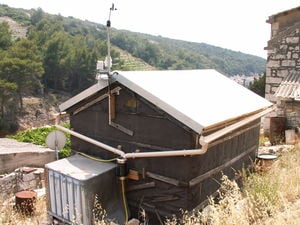The project recommended here is as economical as possible. There are design features, such as thermally insulating the roof, that would add to the dew yield; however they would be quite costly. Instead, what is considered is an appropriate retrofit for a roof to install a dew collection system.
Design
The steepness of the roof is an important criterion. 30o from the horizontal is optimal.[1][2]
The peak of the roof should be aligned co-linearly with the direction of the prevailing wind. This will ensure that the wind flows evenly over the entire roof surface. If the roof peak is perpindicular to the prevailing wind, there will be increased turbulence, and leeward roof side will be negatively impacted.
Gutters are installed along the perimeter of the low end of the roof surface. They should be angled downward at
Regional considerations
large dew yields even far from the coastal area
Construction

It is best to build a roof with dew collection in mind. The roof shape, slope, direction of slant, and material are all considerations. Specifically, roofs made out of plastic or galvinized iron . This article is written for those
Materials
Tools
Skills and Knowledge
Estimated Costs
Case Studies
This study then investigates the extent to which existing roofs, without any modifications except for roof gutters and a collection tank, can collect a substantial amount of dew water. This is the first time that such work is done in India and meteorological data analyses is required to assist in a large-scale dew feasibility study.
The study site is Kothara, India ( 23°14N, λ 68°45E, at 21 m a.s.l.) situated within 20 km from the Arabian Sea on a gulf. It is located in the Rann of Kutch area and near the city of Bhuj, in the Gujarat state. The location is typical of rural north-western India. Annual average rainfall is low (300 mm) and very erratic—the coefficient of variation is 75%. Annual pan evaporation is 2000 mm thus the area is extremely arid.
Most of the population relies on drinking water drawn from open wells. The population pressure is such that the level of the phreatic aquifer is constantly receding. In addition, salt water is now entering the phreatic zone. Water level in the well in Kothara is now 60 m from ground level and the amount available is very small.
Dew is abundant in this area during 8–9 months of the year (from late September to early May). During the remaining months, the monsoon season makes the sky cloudy and dew does not form. It is in this season that some rain occurs but with the number of rainy days as few as 5 or less.
There are many buildings in Kutch that use corrugated galvanized iron (GI) sheets for roofing—hay warehouses, factory sheds, cattle barns, and occasionally schools. Some condensation is visible over these roofs in the season. It was decided therefore to make systematic measurements on a plain, uninsulated, corrugated GI test roof so as to determine the dew water quantity and frequency and check if the quantity is significant for practical use.
Two sloping surfaces were erected on a triangular framed support. The ridge is oriented north–south and is 4 m from the ground. The roofing sheet is made of commercially available corrugated GI 1.5 mm thick. The sheet was new with a shiny surface and the IR emissivity was measured as 0.23. Over time, these sheets become dull with a slight increase in emissivity to 0.3 after many years. The roof was not insulated.
The roof slope is 30° with the left-half (9 m2 area) facing west and the right-half (9 m2 area) facing east. There were separate gutter and collection cylinders installed for each side. The collected water was measured at about 08:00 local time (UT+06:30) each day for one entire season (October 1, 2004–May 31, 2005). The volume of water is measured in graduated glass vessels with accuracy ±5 mL.
Air temperature and relative humidity, windspeed (three cups anemometer at 5 m above the ground) were measured and recorded on site every hour by a data logger (Weather Technologies India). Temperature measurements accuracy is ±0.2 °C (resolution ±0.1 °C), relative humidity accuracy is ±3% (resolution ±0.1%), windspeed accuracy is better than ±0.5 m s−1 with a stalling speed of 0.3 m s−1. Cloud cover observations were obtained from the Indian Meteorological Observatory, Naliya, 10 km northwest of Kothara.
Wind direction data used here was obtained from a weather station (Weather Technologies) at Suthri, 15 km southwest of Kothara. Wind direction measurements are within ±3° accuracy with a resolution of 1° and a starting threshold at most 0.5 m s−1. This sensor was also placed 5 m above the ground. Records are for the period November 1, 2004–May 31, 2005. The terrain between the two sites and in the neighbourhood is flat with no topographical undulations and nearly bare of vegetation. Thus the wind direction in Kothara was taken to be the same as in Suthri.
Total dew collected: 113.5L Number of dew days: 74